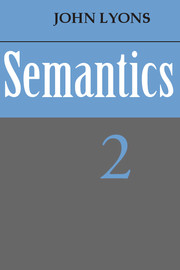Book contents
- Frontmatter
- Contents
- Figures
- Typographical conventions
- Preface
- 10 Semantics and grammar I
- 11 Semantics and grammar II
- 12 Semantics and grammar III
- 13 The Lexicon
- 14 Context, style and culture
- 15 Deixis, space and time
- 16 Mood and illocutionary force
- 17 Modality
- Bibliography
- Index of subjects
- Index of personal names
14 - Context, style and culture
Published online by Cambridge University Press: 05 June 2012
- Frontmatter
- Contents
- Figures
- Typographical conventions
- Preface
- 10 Semantics and grammar I
- 11 Semantics and grammar II
- 12 Semantics and grammar III
- 13 The Lexicon
- 14 Context, style and culture
- 15 Deixis, space and time
- 16 Mood and illocutionary force
- 17 Modality
- Bibliography
- Index of subjects
- Index of personal names
Summary
The context-of-utterance
Any utterance-token that is produced on some particular occasion is an actual utterance (cf. 1.6). In certain situations, the utterance that is produced (as a token of a particular type) is very highly determined by factors which we may describe, loosely for the moment, as contextual. For example, the utterance of Hello when answering the telephone or of Good morning upon entering a shop at a certain time of day is highly determined by the social role that the utterer is playing and his recognition of what utterance-types are appropriate to this role and by a variety of more particular contextual features. Generally speaking, however, we can say that actual utterances are in contrast with indefinitely many potential utterances which might have been actualized on the occasion in question, but were not.
Every actual utterance is spatiotemporally unique, being spoken or written at a particular place and at a particular time; and, provided that there is some standard system for identifying points in space and time, we can, in principle, specify the actual spatiotemporal situation of any utterance-act (which has as its product an actual utterance-signal: cf. 1.6) by giving its spatiotemporal co-ordinates within the framework of the standard system. We can say, for example, that a particular utterance-token was produced by X at 12 noon on 6 January 1971, in Edinburgh; and we can be more or less precise than this in our specification of the spatiotemporal co-ordinates of the utterance-act.
- Type
- Chapter
- Information
- Semantics , pp. 570 - 635Publisher: Cambridge University PressPrint publication year: 1977



